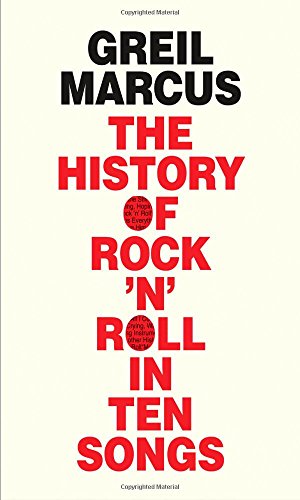
As if to get it over with, Greil Marcus opens his History of Rock ’n’ Roll in Ten Songs with something resembling an official account: a five-page list of names of the inductees to the Rock and Roll Hall of Fame, from Chuck Berry to Nirvana to the likely-to-be-inducted Beyoncé and Jay Z. The point is what the list doesn’t give us. It may be “fun enough” to sift through the memorabilia that depict the story of rock ’n’ roll “in the basically familiar way,” as Marcus quotes the artist Allen Ruppersberg saying after a visit to the Hall of Fame. But no simple, linear history—even, or maybe especially, one that aims for comprehensiveness—can capture the music’s complexity and vigor.
Marcus wants to achieve something at once more incomplete and more total with this book, to “feel [his] way through the music as a field of expression, and as a web of affinities.” The image of a web suits the project, which is not to draw a chronological connection between songs but to choose a handful of counterintuitive examples—“Shake Some Action,” by the Flamin’ Groovies; “Transmission,” by Joy Division; “This Magic Moment” by the Drifters—and extrapolate from them the broader meaning of rock ’n’ roll.
Each chapter of The History focuses on one song, exploring its origins and following its trajectory as other artists discover and reinterpret it. Marcus praises music’s ability to transcend time, space, age, race, and gender. Rock ’n’ roll was invented in Memphis in 1956, he claims, and again in Detroit in 1960, and yet again in Olympia in 1991. As “an argument about life captured in sound,” the music knows no boundaries. Marcus’s free, time-traveling approach reflects this anarchic spirit. He describes a performance by The Drifters’ Ben E. King at a 2007 Lou Reed concert as a “séance,” and, throughout the book, he himself communes with the spirits of dead rock stars, in sprawling, could-have-been tales of artists who died young. (In one scenario, Buddy Holly trades sets with Bob Dylan at a Greenwich Village café in the early 1960s.)
Marcus is at his most thrilling when he describes live performances. Often these passages, like this one on The Brains’ “Money Changes Everything,” take on a preacherly fervor:
An enormous sound appears, with a high, keening fanfare from [Tom] Gray’s organ, one note held down, others circling around it like crows . . . Gray’s vocal was rough, without subtlety, a crying voice without the crying highs of a soul singer, self-pitying, stunned, the voice of someone disgraced by his own stupidity: he believed her when she said she loved him. He believed him when he said he was his friend.
Who else could hear all that in a three-and-a-half minute tune by a little-known ’80s band that only really found an audience when Cyndi Lauper covered their song three years later? Marcus’s descriptions are themselves performances, and they make you want to be a better listener—to discern not just what’s happening in the music but what’s happening to you as you listen. Songs are two-way streets: “You could imagine,” he writes, “as you listened, that as the singer changed the song, the song changed the singer, and you could imagine that both would change you.”
He’s excellent on Joy Division, on Lauper, on the Beatles right before they broke up, and on Phil Spector when he appeared on American Bandstand as a teenager. But in my mind he’s at his best on Beyoncé and Etta James. I was obsessed with James’s music for about two years in high school, and when I hear “All I Could Do Was Cry” I’m transported back to that time, when listening to James was a daily revelation. The ultimate fan’s critic, Marcus understands that we carry personal allegiances based as much on where we were, geographically and emotionally, when we first heard a song as on the song’s virtues.
Marcus’s treatment of the Teddy Bears’ 1958 ballad “To Know Him is to Love Him,” which Amy Winehouse resurrected forty-eight years later, is perhaps the best example of what Marcus does: He shows how a song can begin its life in one decade and find its voice in another. When I was in high school, obsessed with James and Sam Cooke and Otis Redding, I took one look at Winehouse’s winged eyeliner and bloated beehive and swiftly pronounced her a fraud, a shallow pop star trying to steal the glamor of the singers of the ’60s. What did this twenty-two-year-old white girl know about soul? Then I heard “To Know Him is to Love Him,” and I got it. Or, more accurately, I realized she got it. In contrast with the mannerly tones of the original, Winehouse’s half-drunk drawl is raw, filled with emotion. As Marcus puts it, “she unlocked the song.”
To think about the history of rock songs as a progression is to ignore the ongoing conversation between them. It may make archival sense to trace a path from the Rolling Stones to Led Zeppelin to Black Sabbath and on, but this is a rather cold, limited version of the story. Try telling a teenager who’s just heard “Black Dog” for the first time that rock ’n’ roll is dead. Marcus knows it’s not. He maps recordings, re-recordings, and performances as if they’re veins belonging to the same body, warm and breathing and very much alive.
Lara Zarum is a writer living in New York. Her writing has appeared in the Globe and Mail, Slate, the LA Review of Books, Guernica, and Splitsider, among other publications.